Restoration of the PC "Microsha"
In my last article devoted to the assembly of the mounted installation of the Specialist Express PC , I mentioned that I also have the Microsha PC (a clone of the well-known Radio-86RK), which is waiting its time. So this time has come. Today I plan to launch it.

What interesting things can be said about this typewriter? Microsha, this is one of the first Soviet household PC. Its production was established at the Lianozovo Electromechanical Plant. It was produced since 1987 (I was only 4 years old then, and before the appearance of the first PC-01 Spectrum house, there were still 2 years left.
His brain was the famous processor K580VM80, operating at a frequency of 1.78 MHz.
The computer had as much as 32 kilobytes of RAM. From the software, there was only a Monitor in it that occupied 2 kilobytes, located in ROM K573RF2, and allowing to perform primitive, but sufficient for operation actions, such as viewing memory, reading characters from the keyboard, writing to memory cells, and reading-writing to tape which was the main storage place for Microsha programs.
In addition to the magnetic tape, the user could purchase an external ROM with a capacity of 16 kilobytes (assembled on 8 K573RF2 chips) containing 4 programs - a BASIC interpreter, a text editor, an assembler and an assembler loader. This external ROM was supplied as a cartridge and inserted into the upper part of the computer case. To boot from the ROM, it was enough to enter the G8000 Monitor command and press the VK key.
Another feature of the computer, as well as the difference from Radio-86RK, was the presence of the built-in timer K580VI53, which was mainly used to generate sound.
In addition, from the Radio-86RK, Mikrosh differs in that his devices have other addresses, and the character generator is made on ROM K537RF2 and has twice the volume, which made it possible to place Cyrillic and some pseudographics in it. The input / output format on the tape has also changed. Well, thanks to these changes, the source code of the Monitor itself has changed. In this regard, not all programs for Radio-86RK could be launched on Mikrosh without alterations.
For the very same micro-programs, it was written no less. Among the system programs can be noted assembler, disassembler, text editor, graphics program, music editor, monitor RAM, and others. It was also written a lot of game programs, which list there is not enough time and space.
In general, the machine for the second half of the 80s, turned out quite decent. However, it cost about 500 rubles.
I got Mikrosh with tail number 006837, collected in October 1988, performed by 1A, apparently one of the first options, since it contains a large number of corrections in the scheme (more on this later).
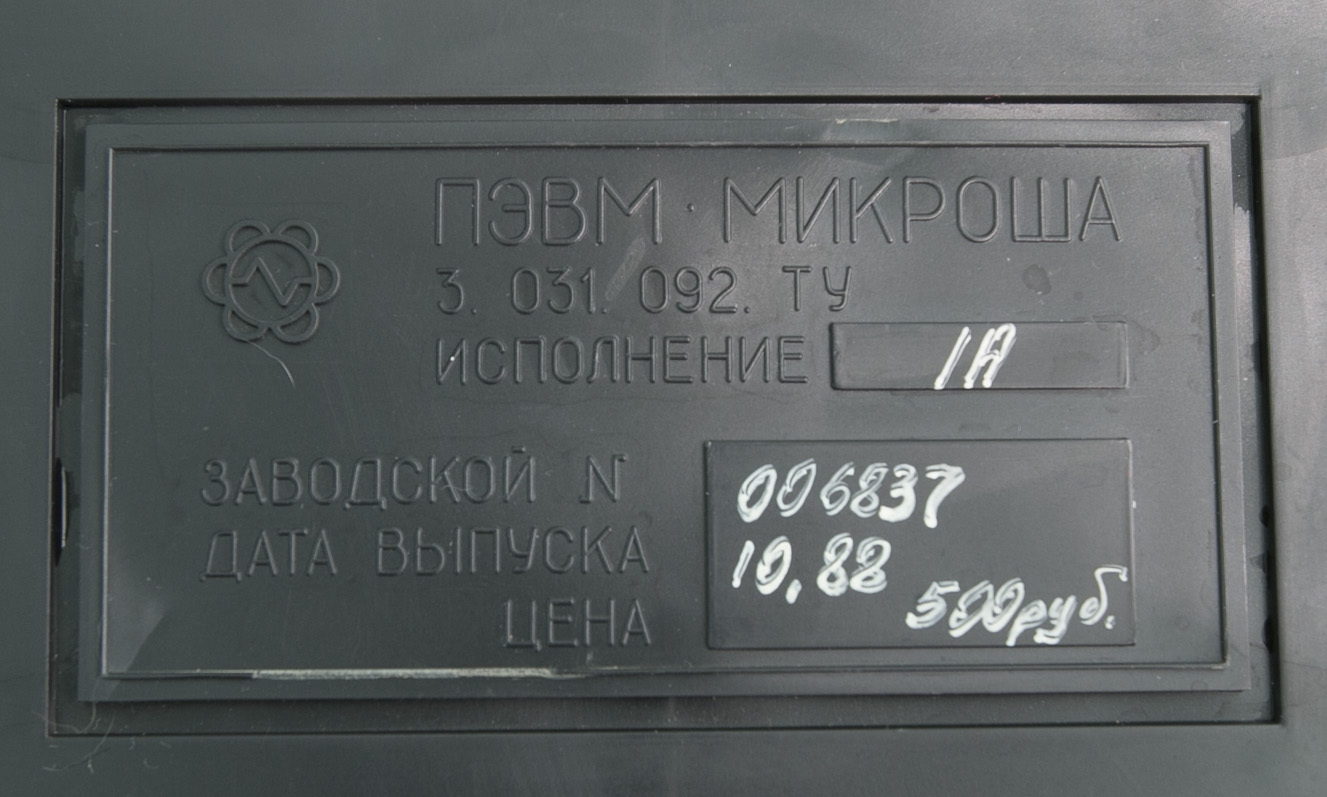
')
Igor Kulchev gave it to me, for which he thanks a lot. Igor actively used it at one time, but now the computer lay in the closet without work. The owner treated him carefully, so the capacitors in it were not bitten, and the whole board was generally in good condition. An external ROM with tail number 000786, collected in February 1991, a lot of documentation and about a dozen tapes of programs and games in machine codes and in BASIC went with the computer. Microsha came to me in 2012. Then I turned it on, it did not work, and since then it has already been on my shelf, although at times my hands itched itched to carry out resuscitation work.
So patient. Having seen his own, and from this a little grimy Microsha.
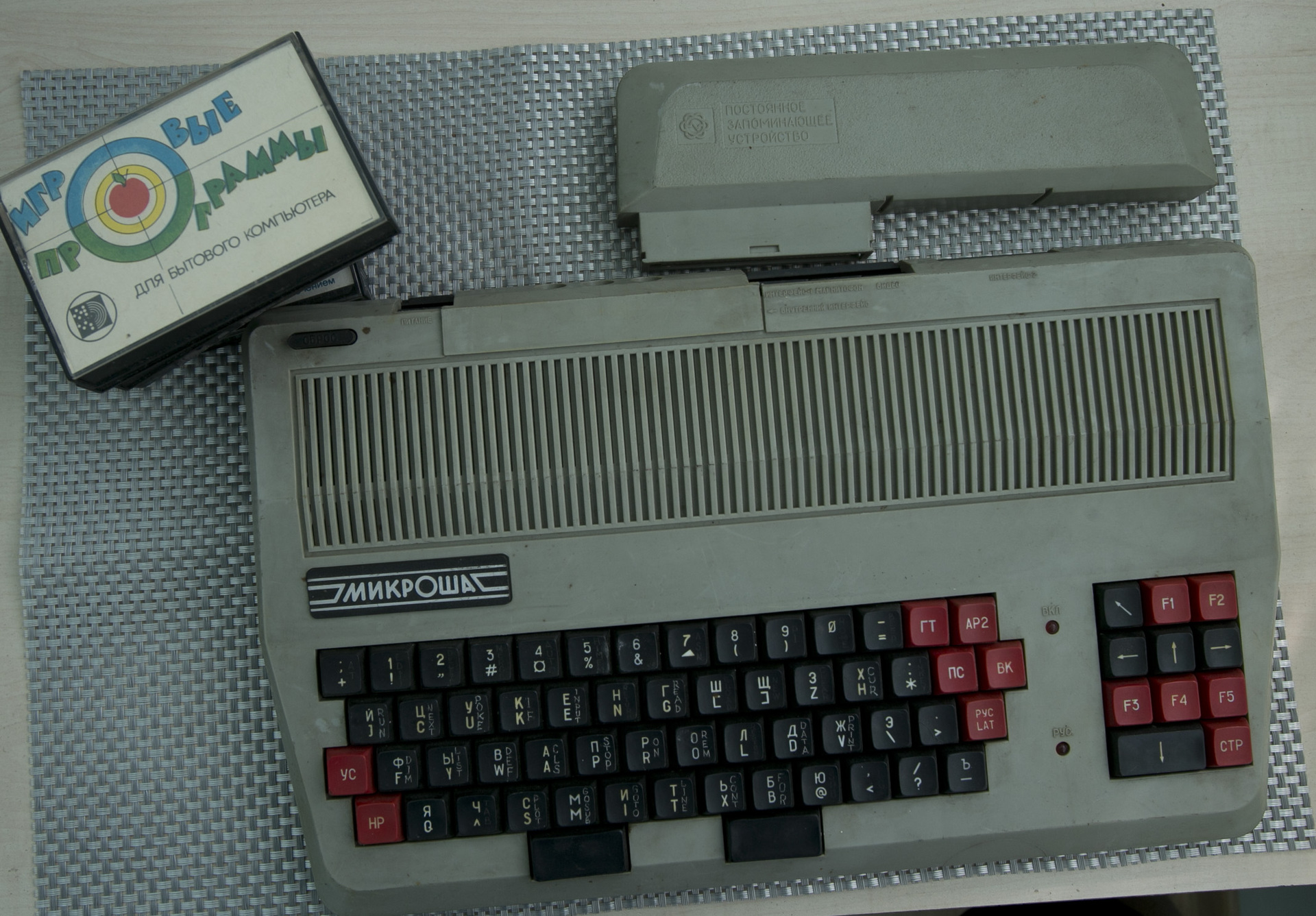
The owner apparently was BASICOVED, and on the keys were tips with the teams.
It is more pleasant to work with a clean and tidy iron, so the first thing I did was wash it, clean all the connectors and keys. The plastic was washed with the simplest sponge with faerie, then dried on the balcony under the spring Sun.

While the case is cox, I took up iron. The power supply, transformer, without any features, issuing honest + 5V, + 12V and -6V. Apparently, the age affected, and some of the capacitors dried up, so the oscilloscope showed a bit of noise at the outputs, but since the board has additional smoothing capacitors built in, I thought it was not fatal.
The power supply is washed and checked.

Next, look around the board. The K155LA3, which is somehow tricky connected to the imaging circuits, is visible to the eyes, apparently for inversion, until I turn it off.

In the middle part of the board there are several hand-welded conductors, filled with glue. Apparently there was a factory marriage on the board and I had to get out on the spot. Moreover, it seems that the board was sherkanuli something sharp, it turned out high-quality and deep cut, which is visible even to the left of BB55, but there were no damage to the conductors. Otherwise, everything is as it should be - oxidized places on the board, dry, from time to time, soldering. 30 minutes of working with a soldering iron, and the top of the board in a suitable form.
Go to the bottom. Things are not bad here either, but many wires are hung among the cut contacts, apparently this is a feature of assembly 1A. Most likely, the board was put into production without waiting for the tests, and was later brought up, at the debugging stage, by factory craftsmen, under the age-old Russian battle, since corrections were required in abundance.
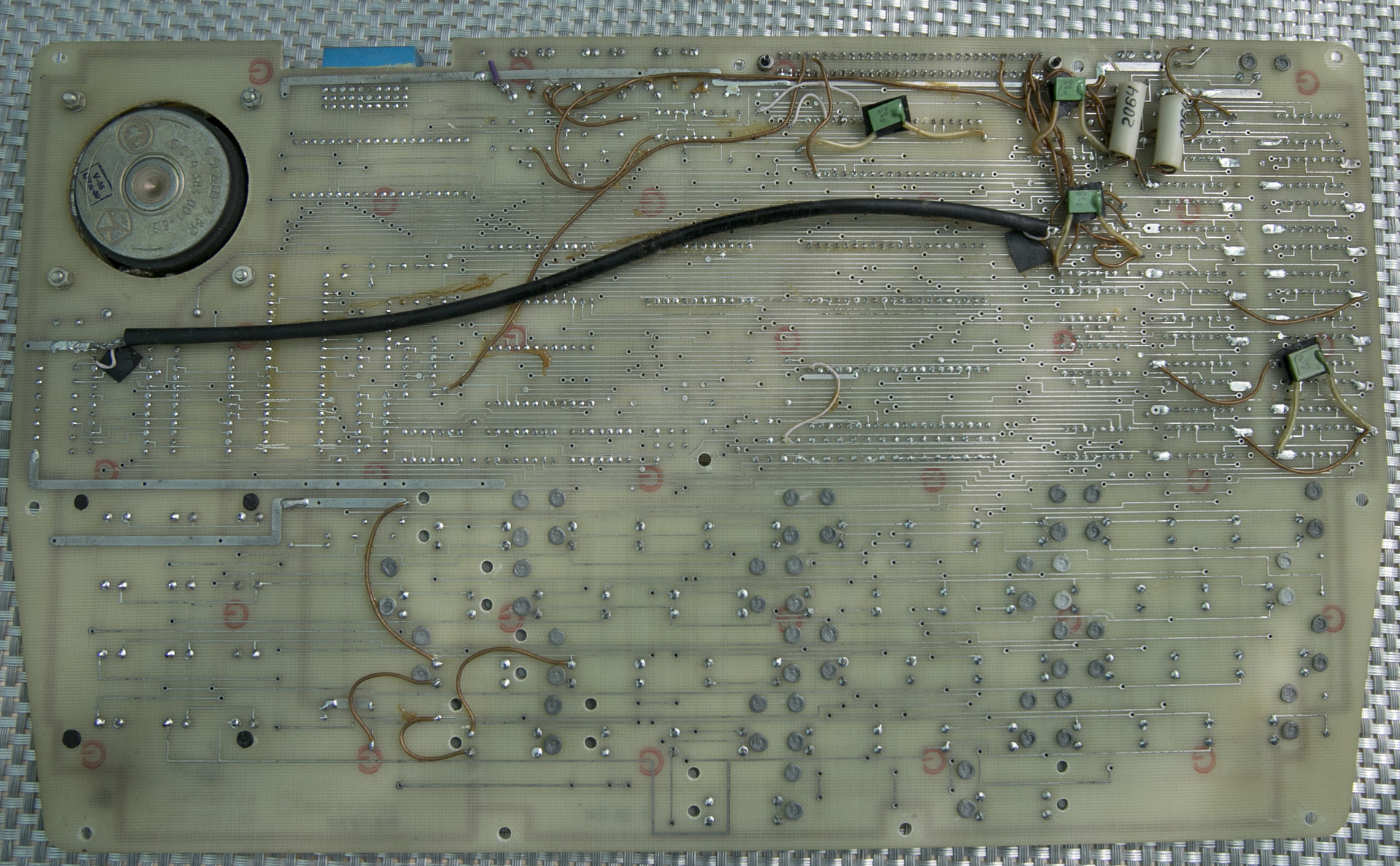
Here it was necessary to solder mostly the keyboard buttons, where the legs simply lagged behind the solder from old age. Half an hour of work as a soldering iron, and the computer is ready for the first start-up.
An exciting moment. Click the power switch toggle and power off. The smoke did not tumble down, the traffic jams in the apartment did not increase, it was already good. Turn on, no image, but the light is on.
I walked along the power supply circuits, all voltages are normal, although instead of -5V it is -6.3V.
Debugging is most logical to start with the master oscillator. In Mikrosh, it is assembled on the K580GF24 microcircuit. The output of F1 had pulses with a frequency of about 20 kHz, there was nothing on F2, which is clearly not the norm. Since only a quartz resonator is needed for its operation, and it is unlikely that he died, I take a bite out of the microcircuit, solder the legs, clean the metallized holes with a toothpick and solder the new K580GF24. Phase generator is working.
I checked the presence of frame and line pulses on the K580VG75 with an oscilloscope, they are, it means most likely the processor, ROM, RAM and small logic chips are intact, and there must be some kind of image.
The image really was, and really "some".

I walked along the video signal shaping scheme, decided to throw out a strange K155LA3, then, after spending another 30 minutes for a dial in and through the conductors, I managed to get a joyful shout of the speaker and the desired greeting. The corpse of Mikroshi came to life.
However, he was still in a fever. A short time after the reset (5-10 seconds), garbage appeared on the screen and the computer did not respond to external influences. The soldering of the conductors gave nothing more, so I returned to the power unit, with its garbage at the exit. I did not have any original capacitors, so I dropped 3 capacitors per 1000 microfarads from the old Gigabyte motherboard and one at 470 microfarads. Two of them soldered on the RAM power bus, one near the character generator ROM and the imaging unit, and the fourth near the I / O port. Just in case, I soldered to the new two electrolyte remaining on the board at 10 microfarads.

After that, the computer earned as needed. After a 15 minute run, he did not go into reboot. It means that food was really to blame.
Start from an external ROM immediately failed. But after cleaning the contacts (I borrowed a nail polish remover from my spouse, and then smelled it with a pile of GOI paste).
ROM started immediately. View before cleaning
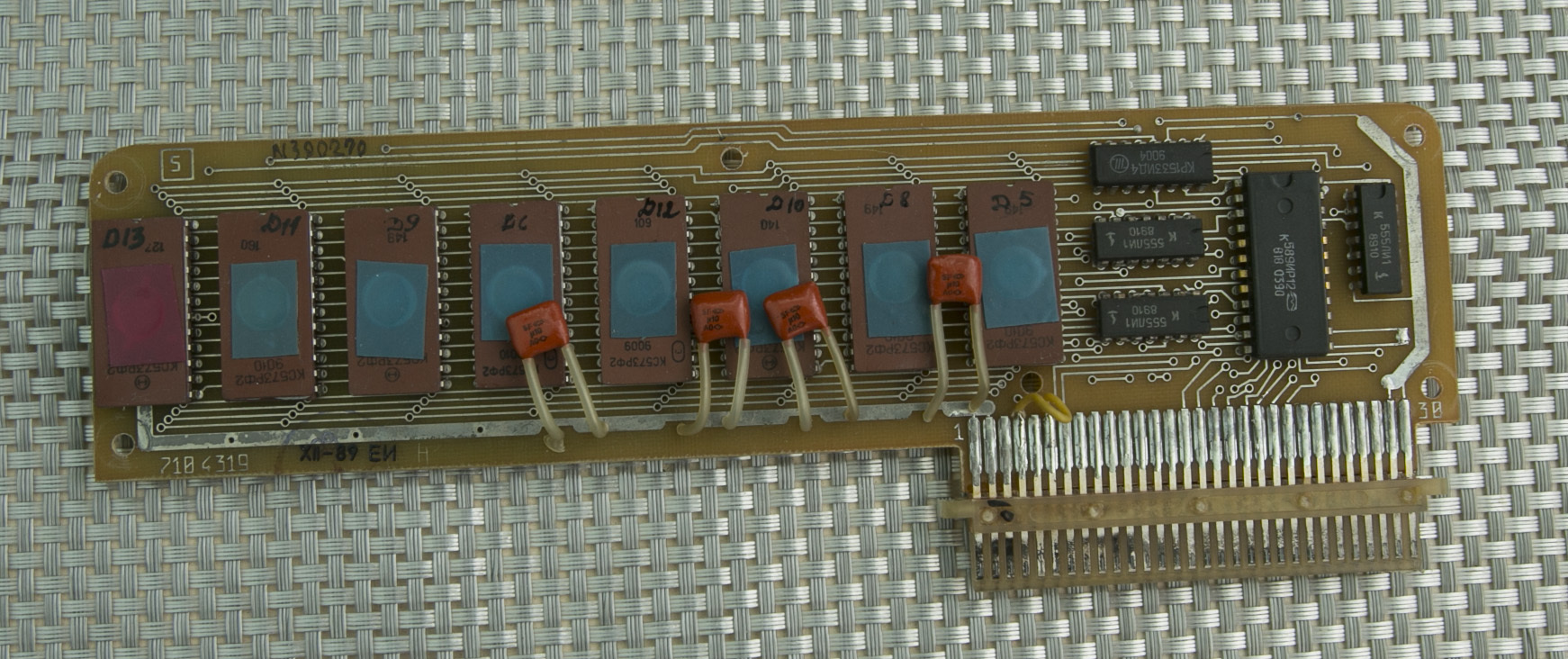
ROM at work
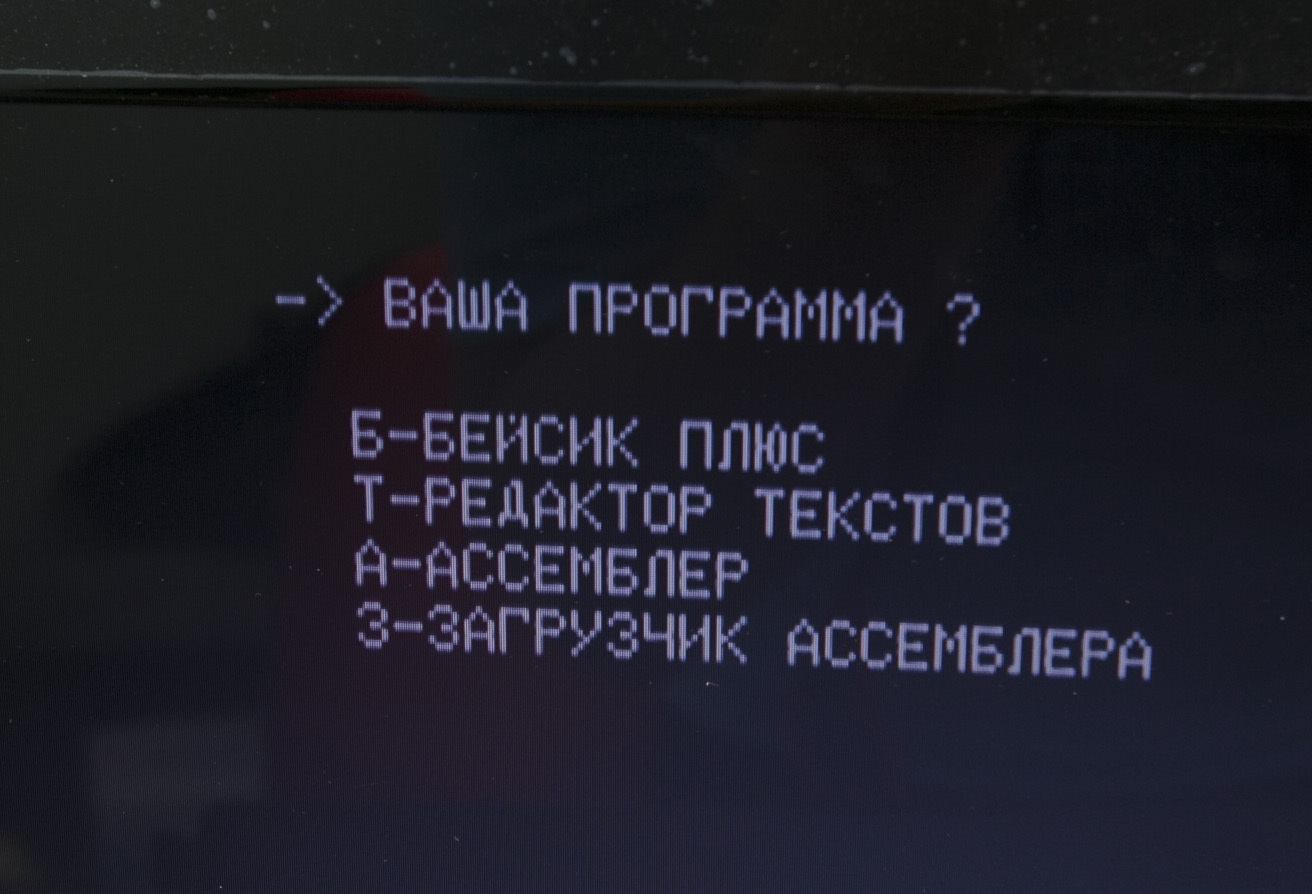
Having pampered with the built-in BASIC (ala 10 PRINT "HELLO MIKROSH"), I quickly soldered a tape-recorder connector. And with the help of the WRKWIN32.EXE utility and the Tetris downloaded into it.
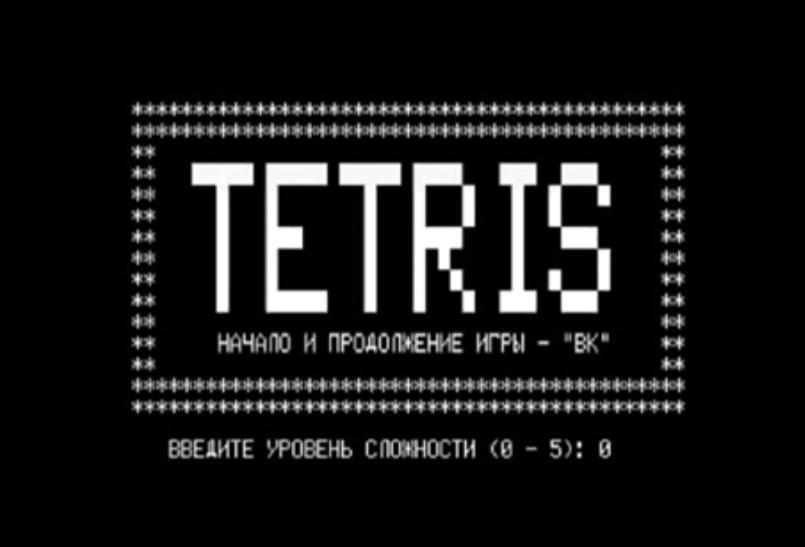
Having played a little, he assembled it in his native building, screwed up the screws and put it on the top, museum shelf, to his relatives from the last century: ZX-Spectrum, PC-01 Lviv, Specialist-Express and Vector-06C.
Appearance of the computer:

There are still cassettes with programs, but I do not have a tape recorder. Perhaps later digitized and lay out for general use.
What application can you think of these computers? Probably in the near future, when I’ve finished collecting Orion-128 and Apple-1, I’ll arrange a chess tournament between them.
Keep, protect, and restore old computers, there is something magical about this. Good luck!

What interesting things can be said about this typewriter? Microsha, this is one of the first Soviet household PC. Its production was established at the Lianozovo Electromechanical Plant. It was produced since 1987 (I was only 4 years old then, and before the appearance of the first PC-01 Spectrum house, there were still 2 years left.
His brain was the famous processor K580VM80, operating at a frequency of 1.78 MHz.
The computer had as much as 32 kilobytes of RAM. From the software, there was only a Monitor in it that occupied 2 kilobytes, located in ROM K573RF2, and allowing to perform primitive, but sufficient for operation actions, such as viewing memory, reading characters from the keyboard, writing to memory cells, and reading-writing to tape which was the main storage place for Microsha programs.
In addition to the magnetic tape, the user could purchase an external ROM with a capacity of 16 kilobytes (assembled on 8 K573RF2 chips) containing 4 programs - a BASIC interpreter, a text editor, an assembler and an assembler loader. This external ROM was supplied as a cartridge and inserted into the upper part of the computer case. To boot from the ROM, it was enough to enter the G8000 Monitor command and press the VK key.
Another feature of the computer, as well as the difference from Radio-86RK, was the presence of the built-in timer K580VI53, which was mainly used to generate sound.
In addition, from the Radio-86RK, Mikrosh differs in that his devices have other addresses, and the character generator is made on ROM K537RF2 and has twice the volume, which made it possible to place Cyrillic and some pseudographics in it. The input / output format on the tape has also changed. Well, thanks to these changes, the source code of the Monitor itself has changed. In this regard, not all programs for Radio-86RK could be launched on Mikrosh without alterations.
For the very same micro-programs, it was written no less. Among the system programs can be noted assembler, disassembler, text editor, graphics program, music editor, monitor RAM, and others. It was also written a lot of game programs, which list there is not enough time and space.
In general, the machine for the second half of the 80s, turned out quite decent. However, it cost about 500 rubles.
I got Mikrosh with tail number 006837, collected in October 1988, performed by 1A, apparently one of the first options, since it contains a large number of corrections in the scheme (more on this later).

')
Igor Kulchev gave it to me, for which he thanks a lot. Igor actively used it at one time, but now the computer lay in the closet without work. The owner treated him carefully, so the capacitors in it were not bitten, and the whole board was generally in good condition. An external ROM with tail number 000786, collected in February 1991, a lot of documentation and about a dozen tapes of programs and games in machine codes and in BASIC went with the computer. Microsha came to me in 2012. Then I turned it on, it did not work, and since then it has already been on my shelf, although at times my hands itched itched to carry out resuscitation work.
So patient. Having seen his own, and from this a little grimy Microsha.

The owner apparently was BASICOVED, and on the keys were tips with the teams.
It is more pleasant to work with a clean and tidy iron, so the first thing I did was wash it, clean all the connectors and keys. The plastic was washed with the simplest sponge with faerie, then dried on the balcony under the spring Sun.

While the case is cox, I took up iron. The power supply, transformer, without any features, issuing honest + 5V, + 12V and -6V. Apparently, the age affected, and some of the capacitors dried up, so the oscilloscope showed a bit of noise at the outputs, but since the board has additional smoothing capacitors built in, I thought it was not fatal.
The power supply is washed and checked.

Next, look around the board. The K155LA3, which is somehow tricky connected to the imaging circuits, is visible to the eyes, apparently for inversion, until I turn it off.

In the middle part of the board there are several hand-welded conductors, filled with glue. Apparently there was a factory marriage on the board and I had to get out on the spot. Moreover, it seems that the board was sherkanuli something sharp, it turned out high-quality and deep cut, which is visible even to the left of BB55, but there were no damage to the conductors. Otherwise, everything is as it should be - oxidized places on the board, dry, from time to time, soldering. 30 minutes of working with a soldering iron, and the top of the board in a suitable form.
Go to the bottom. Things are not bad here either, but many wires are hung among the cut contacts, apparently this is a feature of assembly 1A. Most likely, the board was put into production without waiting for the tests, and was later brought up, at the debugging stage, by factory craftsmen, under the age-old Russian battle, since corrections were required in abundance.

Here it was necessary to solder mostly the keyboard buttons, where the legs simply lagged behind the solder from old age. Half an hour of work as a soldering iron, and the computer is ready for the first start-up.
An exciting moment. Click the power switch toggle and power off. The smoke did not tumble down, the traffic jams in the apartment did not increase, it was already good. Turn on, no image, but the light is on.
I walked along the power supply circuits, all voltages are normal, although instead of -5V it is -6.3V.
Debugging is most logical to start with the master oscillator. In Mikrosh, it is assembled on the K580GF24 microcircuit. The output of F1 had pulses with a frequency of about 20 kHz, there was nothing on F2, which is clearly not the norm. Since only a quartz resonator is needed for its operation, and it is unlikely that he died, I take a bite out of the microcircuit, solder the legs, clean the metallized holes with a toothpick and solder the new K580GF24. Phase generator is working.
I checked the presence of frame and line pulses on the K580VG75 with an oscilloscope, they are, it means most likely the processor, ROM, RAM and small logic chips are intact, and there must be some kind of image.
The image really was, and really "some".

I walked along the video signal shaping scheme, decided to throw out a strange K155LA3, then, after spending another 30 minutes for a dial in and through the conductors, I managed to get a joyful shout of the speaker and the desired greeting. The corpse of Mikroshi came to life.
However, he was still in a fever. A short time after the reset (5-10 seconds), garbage appeared on the screen and the computer did not respond to external influences. The soldering of the conductors gave nothing more, so I returned to the power unit, with its garbage at the exit. I did not have any original capacitors, so I dropped 3 capacitors per 1000 microfarads from the old Gigabyte motherboard and one at 470 microfarads. Two of them soldered on the RAM power bus, one near the character generator ROM and the imaging unit, and the fourth near the I / O port. Just in case, I soldered to the new two electrolyte remaining on the board at 10 microfarads.

After that, the computer earned as needed. After a 15 minute run, he did not go into reboot. It means that food was really to blame.
Start from an external ROM immediately failed. But after cleaning the contacts (I borrowed a nail polish remover from my spouse, and then smelled it with a pile of GOI paste).
ROM started immediately. View before cleaning

ROM at work

Having pampered with the built-in BASIC (ala 10 PRINT "HELLO MIKROSH"), I quickly soldered a tape-recorder connector. And with the help of the WRKWIN32.EXE utility and the Tetris downloaded into it.

Having played a little, he assembled it in his native building, screwed up the screws and put it on the top, museum shelf, to his relatives from the last century: ZX-Spectrum, PC-01 Lviv, Specialist-Express and Vector-06C.
Appearance of the computer:

There are still cassettes with programs, but I do not have a tape recorder. Perhaps later digitized and lay out for general use.
What application can you think of these computers? Probably in the near future, when I’ve finished collecting Orion-128 and Apple-1, I’ll arrange a chess tournament between them.
Keep, protect, and restore old computers, there is something magical about this. Good luck!
Source: https://habr.com/ru/post/256085/
All Articles